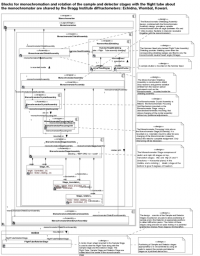systems engineering
Dr Darren says: Don't be scared to put yourself out there with your SysML Diagrams in public and in your work with colleagues
Many years ago, on a very old version of the Webel site, I had up a quick attempt at mapping out the families of physics particles in SysML. Although I have a PhD in physics (astrophysics), and had even worked at the DESY particle accelerator institute (on data analysis, and modelling and operating the machines, not particle physics), I am not an expert in particle physics.
Dr Darren's Open Letter to the LinkedIn groups for MBSE, SysML, MagicDraw, and INCOSE concerning comment and message replies
I am no longer offering comments or answering questions in comment threads (or in reply to LinkedIn messages) on any LinkedIn group involving MBSE, SysML, or SysML tools.
Topic outline for Full SysML Workshop (5-Day) course version: Model-based systems engineering with the OMG's Systems Modeling Language v1 (SysML®) and the SysML Plugin for MagicDraw® and Cameo™ (CATIA Magic)
[WCA-SYSML-CSM-5] - 'Full SysML Workshop (5-Day)'
Topic outline for Mini SysML Workshop (4-Day) and SysMLv1 Language Intro (4-Day or 3-Day) course versions: Model-based systems engineering with the OMG's Systems Modeling Language v1 (SysML®) and the SysML Plugin for MagicDraw® and Cameo™
[WCA-SYSML-CSM-4] - 'Mini SysML Workshop (4-Day)'
[WCA-SYSML-LAN-4] - 'SysML Language Intro (4-Day)'
MagicDraw SysML Plugin zone
[ARCHIVAL] Gallery: Port-based systems engineering of block models for control and simulation of Neutron Beam Instruments of the OPAL research reactor using UML/SysML (from 2007, online extracts)
Slides in this gallery
Ultra Electronics (Avalon Systems)
ANU Advanced Instrumentation and Technology Centre (AITC)
Project Performance International (PPI)
Webel IT designed and operated the Systems Engineering Goldmine resources web site for PPI from 2009 to 2020.
Service: Model-Based Systems Engineering with SysML
Screencast: MagicDraw SysML/Cameo analysis: Possible "gotchas" when extending the SysML Block stereotype
Video style
Audience: Users of MagicDraw SysML or Cameo Systems Modeler who are experimenting with creating custom stereotypes that extend Block.
This screencast video has been created to demonstrate some issues that can arise if you "naively" create a custom stereotype that extends Block without: (1) closing then re-opening your project; (2) creating an appropriate MD Customization. It is not about any actual "bug" in MagicDraw/Cameo (as long as you follow the recommended procedure). If you watch it, please do watch it to the end to find how to handle such stereotypes properly.
Screencast: MagicDraw SysML/Cameo: Pros and Cons of custom stereotypes in combination with Block inheritance and Part Property structures
Video style
Audience: Users of MagicDraw SysML or Cameo Systems Modeler who are experimenting with creating custom stereotypes for SysML.
This screencast video has been created to illustrate some pros and cons of using custom stereotypes in combination with Block inheritance and Part Property structures, and demonstrates some possible "gotchas". It concerns especially use of custom stereotypes to indicate: (1) cross-cutting aspects such as model layer membership; (2) use of tagged values to carry per-Element metadata.
Course: Model-Based Systems Engineering with the OMG's Systems Modeling Language® (v1) and the SysML Plugin for MagicDraw® and Cameo™ (CATIA Magic)
Magic Cyber-Systems Engineer® (Cameo Systems Modeler®) zone
- MagicDraw Enterprise
- SysML Plugin
- Cameo Requirements Modeler Plugin
- Cameo DataHub Plugin
- Merge Plugin
- Cameo Data Modeler Plugin
Magic Cyber-Systems Engineer® (Cameo Systems Modeler®) is a Model-Based Systems Engineering (MBSE) en
MagicDraw UML (Magic Software Architect) zone
The Webel Parsing Analysis recipe for UML
This zone is about a version of the Webel Parsing Analysis recipe for document-driven, model-based, graphical software engineering with Unified Modeling Language (UML®).
The Webel Parsing Analysis recipe for SysML
SysML zone
You have arrived at the world's most comprehensive online guide to applying Model-Based Systems Engineering with SysML® to real-world systems.

















